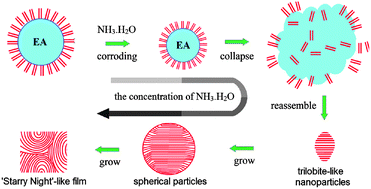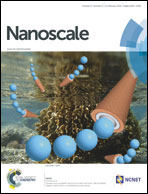A novel liquid template corrosion approach for layered silica with various morphologies and different nanolayer thicknesses†
Abstract
A novel liquid template corrosion (LTC) method has been developed for the synthesis of layered silica materials with a variety of morphologies, including hollow nanospheres, trilobite-like nanoparticles, spherical particles and a film resembling the van Gogh painting ‘Starry Night’. Lamellar micelles and microemulsion droplets are first formed in an oil–water (O/W) mixture of ethyl acetate (EA), cetyltrimethylammonium bromide (CTAB) and water. After adding aqueous ammonia the EA becomes hydrolyzed, which results in corrosion of microemulsion droplets. These droplets subsequently act as templates for the synthesis of silica formed by hydrolysis of tetraethyl orthosilicate. The morphological evolution of silica can be tuned by varying the concentration of aqueous ammonia which controls the degree of corrosion of the microemulsion droplet templates. A possible mechanism is proposed to explain why the LTC approach affords layered silica nanostructured materials with various morphologies and nanolayer thickness (2.6–4.5 nm), rather than the usual ordered mesostructures formed in the absence of EA. Our method provides a simple way to fabricate a variety of building blocks for assembling nanomaterials with novel structures and functionality, which are not available using conventional template methods.


 Please wait while we load your content...
Please wait while we load your content...